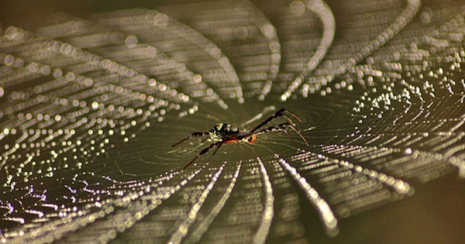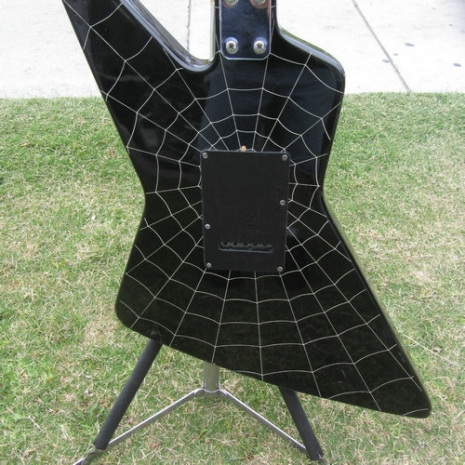
Aracnus at
Ah essas aranhas e suas genialidades... ;-)
Spiders ‘Tune’ Their Webs Like Guitar Strings...

Researchers from the UK and Spain have shown that spiders are capable of tuning their webs, allowing these eight-legged critters to receive specific information about their environment, including the presence of prey, potential mates, and the structural condition of the web.
Similar to the strings of a finely tuned instrument, each strand of spider silk transmits vibrations across a wide range of frequencies, which propagates throughout the web. This allows spiders, who don't see very well, to sense the integrity of their webs, and to detect the presence of prey and mates.
Scientist have known about this for years, but they weren't entirely sure about the precise characteristics of these vibrations, or if spiders had any control over this cool architectural feature. To learn more, researchers from Oxford University and Universidad Carlos III de Madrid explored the links between the material properties of spider webs and how vibrations propagate through the silken strands. Their study, which now appears in the Journal of the Royal Society Interface, demonstrates that spiders can in fact tune their webs to transmit specific messages.

Using high-powered lasers to measure the ultra-small vibrations, the researchers isolated three particular web features that allow spiders to turn their traps into data transmitters: web tension, silk stiffness, and overall web architecture. Importantly, spiders are able to manipulate all three of these characteristics.
For example, both transverse waves, i.e. waves that vibrate at right angles to the direction of its spread, and longitudinal waves, i.e. waves that vibrate in the direction of propagation, can be adjusted, or tuned, by the spider when it adjusts the web's tension and the stiffness of the web's outer rim and spokes, known as the dragline. In fact, spider webs are so customizable, the researchers hypothesize that specific features of silk evolved for this very purpose.
"[We] propose that dragline silk [features] may have evolved as a control mechanism for these multifunctional fibres," write the authors in their study. "The various degrees of active influence on web engineering reveals the extraordinary ability of spiders to shape the physical properties of their self-made materials and architectures to affect biological [i.e. data transmission] functionality."

So when a spider builds its web, it's not just constructing a trap and blindly hoping its design will lend itself well to the propagation of specific vibrations. Rather, the spider is working like a diligent engineer, building a stable web that performs its primary trapping function, while also optimizing the web's ability to relay critical information. It's essentially constructing—and then fine-tuning—its web to be a multi-function device.
At the same time, the spider has to constantly balance trade-offs between the structural integrity of the web and the web's ability to transmit signals at specific frequencies.
Wow. Spiders are truly amazing.
[+]
#spiders #tuning #web

Researchers from the UK and Spain have shown that spiders are capable of tuning their webs, allowing these eight-legged critters to receive specific information about their environment, including the presence of prey, potential mates, and the structural condition of the web.
Similar to the strings of a finely tuned instrument, each strand of spider silk transmits vibrations across a wide range of frequencies, which propagates throughout the web. This allows spiders, who don't see very well, to sense the integrity of their webs, and to detect the presence of prey and mates.
Scientist have known about this for years, but they weren't entirely sure about the precise characteristics of these vibrations, or if spiders had any control over this cool architectural feature. To learn more, researchers from Oxford University and Universidad Carlos III de Madrid explored the links between the material properties of spider webs and how vibrations propagate through the silken strands. Their study, which now appears in the Journal of the Royal Society Interface, demonstrates that spiders can in fact tune their webs to transmit specific messages.

Using high-powered lasers to measure the ultra-small vibrations, the researchers isolated three particular web features that allow spiders to turn their traps into data transmitters: web tension, silk stiffness, and overall web architecture. Importantly, spiders are able to manipulate all three of these characteristics.
For example, both transverse waves, i.e. waves that vibrate at right angles to the direction of its spread, and longitudinal waves, i.e. waves that vibrate in the direction of propagation, can be adjusted, or tuned, by the spider when it adjusts the web's tension and the stiffness of the web's outer rim and spokes, known as the dragline. In fact, spider webs are so customizable, the researchers hypothesize that specific features of silk evolved for this very purpose.
"[We] propose that dragline silk [features] may have evolved as a control mechanism for these multifunctional fibres," write the authors in their study. "The various degrees of active influence on web engineering reveals the extraordinary ability of spiders to shape the physical properties of their self-made materials and architectures to affect biological [i.e. data transmission] functionality."

So when a spider builds its web, it's not just constructing a trap and blindly hoping its design will lend itself well to the propagation of specific vibrations. Rather, the spider is working like a diligent engineer, building a stable web that performs its primary trapping function, while also optimizing the web's ability to relay critical information. It's essentially constructing—and then fine-tuning—its web to be a multi-function device.
At the same time, the spider has to constantly balance trade-offs between the structural integrity of the web and the web's ability to transmit signals at specific frequencies.
Wow. Spiders are truly amazing.
[+]
#spiders #tuning #web